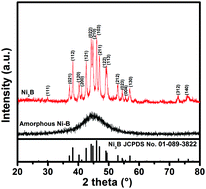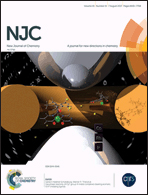Direct aqueous solution synthesis of an ultra-fine amorphous nickel–boron alloy with superior pseudocapacitive performance for advanced asymmetric supercapacitors†
Abstract
This study reports a facile aqueous solution synthesis of an ultrafine amorphous nickel–boron alloy and its applications as a novel positive electrode material for asymmetric supercapacitors. The electrochemical properties of the as-prepared amorphous Ni–B alloy were studied, and the results demonstrate that the material synthesized at room temperature shows a high specific capacitance of 2230 F g−1 at 1 A g−1 in a three-electrode system, and the capacitance remained at 986 F g−1 when the current density is increased up to 20 A g−1. An amorphous Ni–B//AC (activated carbon) asymmetric supercapacitor is successfully assembled with the amorphous Ni–B alloy as the cathode and AC as the anode. Such an assembled device shows a high specific capacitance of 135.5 F g−1 at 1 A g−1. It can deliver a maximum energy density of 59.3 W h kg−1 at a power density of 1004 W kg−1, better than most of the supercapacitors reported in the literature. Furthermore, this asymmetric supercapacitor also exhibits an excellent, long cycle life along with 88.2% specific capacitance retention after 5000 consecutive cycles. Our results show that the amorphous nickel–boron alloy, as a new type of high-performance electrode material, is promising for advanced supercapacitor applications.



 Please wait while we load your content...
Please wait while we load your content...